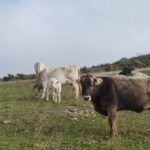Des que el 2004 vam començar a plantar vinya a Mas Marès, al Cap de Creus, sabíem que volíem respectar al màxim l’ecosistema existent i fins i tot aportar-li més riquesa. Us expliquem què és el mosaic i com el treballem a Mas Marès fins crear el que s’anomena tècnicament un sistema agrari d’alt valor natural.
Ja fa quasi vint anys que vam comprar les vinyes de Mas Marès. De seguida ens vam posar en contacte amb el Parc Natural del Cap de Creus per treballar conjuntament en la gestió d’aquell tros de territori. Les vinyes estarien inserides en un espai natural que estimem, calia fer-ho bé. A més, conscients que la mà dels ésser humans hi ha estat present des de fa milers d’anys (dòlmens i menhirs ho certifiquen) calia una gestió integrada de totes les terres.
Mas Marès i tot el Cap de Creus és un paisatge que meravella a tothom que ens ve a conèixer. Darrere de la bellesa hi ha sí o sí una gestió, imprescindible. El 2004 amb l’ajuda de Xavi Vilavella, tècnic del Parc Natural en aquell moment, i de l’Anna Sanitjas, enginyera forestal que va fer el projecte tècnic de gestió i millora forestal, vam idear la distribució del mosaic a Mas Marès. El pla de gestió de les terres tenien i tenen en compte uns objectius compartits:
- prevenció d’incendis forestals
- augment progressiu de la biodiversitat
- protecció de les espècies en perill d’extinció
- eliminació de plantes invasores
Els elements del mosaic de Mas Marès
El mosaic o sistema agrari d’alt valor natural fa el territori més resilient al canvi climàtic, als incendis, i li aporta més capacitat per nínxols ecològics, per tant més biodiversitat. Les quatre unitats del mosaic de Mas Marès, al Cap de Creus, estan distribuïts estratègicament en quatre unitats que es retroalimenten creant un cercle virtuós, un ecosistema equilibrat:
- pastures: s’han mantingut les velles, amb les vaques, i se n’han anat creant de noves, desbrossant. Són a la part Nord i per tant la zona més exposada a perills com el foc
- vinyes i oliveres: amb coberta vegetal verda a la tardor, hivern i primavera. A l’estiu es treballen les zones que limitem amb el matollar, per a fer de tallafocs.
- suredes: regenerar aquests espais és clau, són ecosistema madur, evolucionat en aquesta zona, perquè sempre n’hi ha hagut. Hem mantingut les que hi havia, hem netejat el sotabosc mantenint els plançons
- zones sense intervenció: a l’extrem sud, és on hi ha els ecosistemes més establerts. Els deixem que evolucionin de forma natural cap a ecosistemes més madurs a nivell de diversitat. Interessa protegir-los al màxim.
Les zones es distribueixen en funció de la vulnerabilitat de l’ecosistema que volem protegir. En el cas del mosaic de Mas Marès, la zona Nord és clarament la zona més exposada a incendis i per tant a pèrdues. Per tenir un mosaic equilibrat és imprescindible la cura de totes les unitats que requereixen intervenció. Si ho voleu escoltar en paraules de l’Anna Espelt us recomanem aquest episodi de Bar de Vins.






